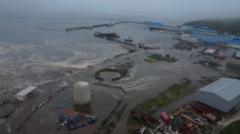A significant 8.8 magnitude earthquake struck off the far eastern coast of Russia, near the Kamchatka Peninsula, at approximately 11:25 AM local time (00:25 AM BST) on Wednesday. This seismic event is noted to be one of the strongest ever recorded, prompting tsunami alerts throughout the Pacific region. Countries including Japan, Russia, the United States, China, the Philippines, Indonesia, New Zealand, and even as far away as Peru and Mexico are taking precautionary measures by issuing evacuation orders.
In the immediate aftermath, footage showed substantial waves crashing into the town of Severo-Kurilsk in Russia, leading to reports of flooding in the port area as well as at a fish processing facility. The event has also caused disruption of the power grid in the Sakhalin region. As a precaution, Japanese authorities have advised approximately 1.9 million individuals to evacuate, urging them to seek higher ground, with some residents taking refuge on rooftops in Hokkaido.
In Hawaii, officials have raised alerts regarding potential 10ft waves; however, Governor Josh Green reported that there has not yet been a "wave of consequence." Authorities anticipate it may take an additional two to three hours before an official "all clear" can be declared.
The overall extent of the impending damage remains uncertain, as tsunami waves continue to traverse the Pacific Ocean. Chris Goldfinger, a Marine Geology Professor at Oregon State University, suggested that damage will vary depending on specific coastal regions. These areas directly aligned with the energy radiating from Kamchatka's Kamchatka Peninsula are likely to experience the most significant impacts, as the tsunami's energy travels southeast from the epicenter.
The timeline indicates that parts of British Columbia and California may begin experiencing tsunami waves by 12:20 AM local time (09:20 AM BST), and Nome, Alaska is expected to see waves around 03:20 AM (12:20 PM BST). According to Helen Janiszewski, an assistant professor of geophysics at the University of Hawaii, tsunami waves can travel at jet plane speeds, thus the timing of their arrival can be estimated accordingly.
The earthquake, recorded at a relatively shallow depth of 19.3 km (12 miles), was initially rated 8.0 before being upgraded. It stands as the sixth most severe earthquake in recorded history, sharing this distinction with the 2010 Biobío, Chile earthquake. This event is a reminder of the ongoing need for preparedness in earthquake-prone regions, as authorities continue to assess the full ramifications of this natural disaster.


















